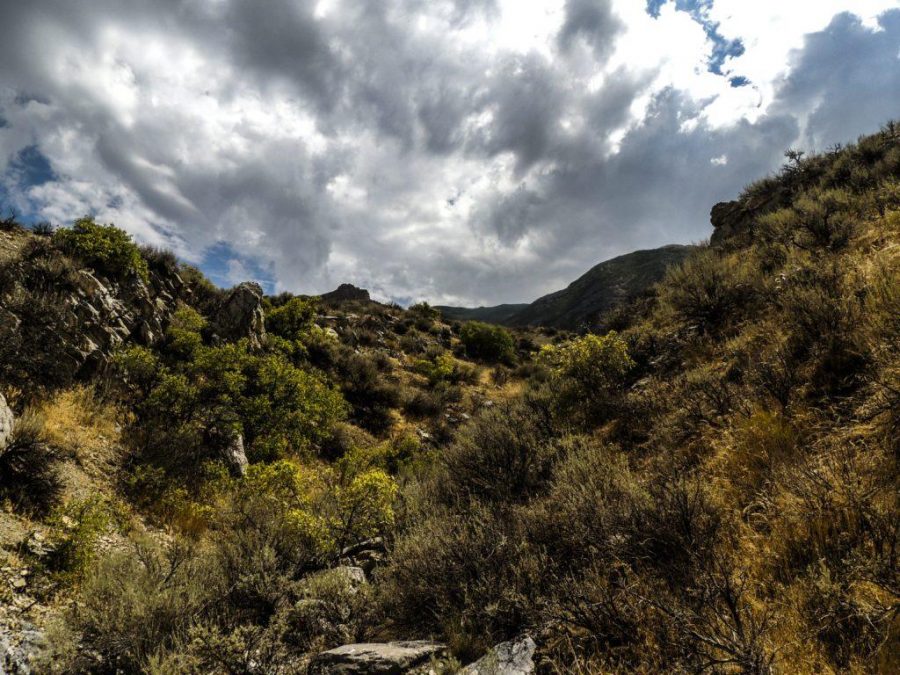Veiled in mystery by the legalities and the eminence of the adjacent Wasatch mountains, the Oquirrh Range serves as the 10,000 feet dividing line between the Salt Lake and Tooele valleys. Equipped solely with the knowledge of a BLM public lands route provided by an outdated hiking guide, and a strong desire to summit a couple of the Oquirrh’s more prominent mountain tops, I took to the westernmost ridge of Kessler Peak.
It seems that the majority of Salt Lake residents simply lack the desire to trek into the Oquirrhs, given the close proximity of the sublime, and comparably larger Wasatch Range. Those who have opened their minds and weekends to the western green peaks have often suffered for it. They are met with the intimidating barrier of red tape and prohibitions deterring even the most intrepid outdoorsmen from entering for fear of hefty fines — or worse. Painfully evident by the violently dissolved mountain that is now the main Kennecott mining facility, the Oquirrh Range remains in a perpetual state of contractual inaccessibility since Rio Tinto’s colossal 1872 land grab that still holds control to this day.
With this corporate acquisition and grand expanses of private purchases, virtually the entire eastern face of the Oquirrhs is restricted to public use (with some exceptions to the far south). While some exploit the negligence of private landowners and trail-blaze in this region outside of the law, those who prefer risk-free, legal natural emersion are ultimately out of luck. Thankfully, the back westernmost face of the range offers a patchy network of BLM land allowing access to those extra-determined to explore Oquirrh terrain without paying heavily for it.
Following the guidance and antiquated advice of a 7-year-old online hiking guide, I made my way to that western back side with hopes of surmounting the ridgeline connecting Kessler and Farnsworth Peaks without deliberately breaking any laws. The guide I relied on did accurately get me to the approximate location of an access point, though it failed to compensate for the nascent housing developments along the base of these mountains.
The overlying drawback of hiking in a largely neglected public land is the total absence of trails, and the consequential abundance of wildlife and wilderness left to flourish independently of human obstruction. When I arrived, I was without the helpful understanding that the access point was at the perpendicular bend, and I began much farther back than I ought to have. I was thus left to bushwhack through dense, arid fields of overgrown dead grass, and the ubiquitous webs of hobo spider webs strung among them (yes, hobo spiders). Long pants and socks are highly recommended in this area in anticipation of the venomous arachnids that call it home — exercise caution.
Aside from the apparent danger of overgrown desert wilderness, the back face of the Oquirrh Range is beautiful. It serves as a tangible reminder of the desolate nature the remaining untamed American West provides.
While my lack of preparation and foresight forced my dejected party to turn back before completing the trek, an impetuous push up the ridge will eventually place you atop Kessler Peak. It is connected by an extended ridgeline to Farnsworth Peak, the more dominant of the two. Note: A section of this ridgeline is private land. Trespassing is not encouraged and would be done at your own risk.
Even if not for the explicit purpose of surmounting some of the more obscure peaks surrounding the Salt Lake Valley, exploration west of the Oquirrhs is sure to provide you with a palpable sense of connectivity with our forgotten 19th-century wild-western past. At the very least, you will come across the disheveled rusted railway spikes, and the scattered animal bones that are evocative of it. The radiant and largely untouched natural beauty is something worth seeing.
Immersion into this incredible yet inhospitable expanse requires only preparation and consciousness; all else is scenery.



Cybele
Jun 22, 2019 at 5:38 pm
Hobo spiders are very hard to tell apart from their hugely more prevalent non-poisonous lookalikes. Subtle markings such as faint dark bands on the legs mean a lookalike spider is not a hobo. It can be hard to discern these bands without a magnifier. To absolutely distinguish a hobo from its more common pals requires microscopic examination of spider genitalia. See Univ of Utah”s arachnid identification info. So, unless you have specific training in arachnid science I highly doubt your comment about “yes, hobos.” But hey, that portion of your article alone will keep the masses away…just how I like it.